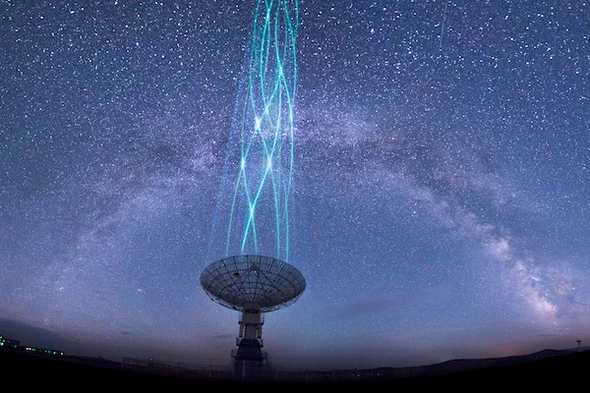What Will Humans Do If Aliens Invade Planet Earth? This has been one of the topics that have baffled science fans and scientists for ages, and we already may have an indication of how people will respond.
On 30th October, 1938, a dramatized edition of the 1898 H.G. Wells’ novel titled “The War of the Worlds” played on the CBS Radio system across the United States of America. The story explained how Martians ambushed Earth.
The radio broadcast resulted in a conclusion when people misunderstood it for a true radio report but accounts offer as to how much of a reaction there was during that period.
Some accounts interpret nationwide fear, while others say not very many people certainly heard the broadcast. The promise of alien life stars in Episode 1 of “AMC Visionaries: James Cameron’s Story of Science Fiction,” which debuts on AMC tonight.
Still, Search for Extraterrestrial Intelligence (SETI) researcher Duncan Forgan notified Space.com that the “War of the Worlds” broadcast may be informative to believe about as SETI scientists worldwide update their “first contact” procedures.
“If you pick the right science fiction — the hard science fiction — it’s placed in the best possible educated guesses about what will happen,” said Forgan, a research fellow at the University of St Andrews in Scotland.
According to him, that “hard” science-fiction correlates to science-fiction that accentuates accuracy.
If researchers discover a signal today, Forgan announced that, one of the things they will have to regulate is a public used to getting continual news updates on Twitter and other social media platforms. This is something Forgan and his mates are already working on.
The International Academy of Astronautics SETI Permanent Committee developed a post-detection protocol in the year 1989 that was slowly updated in the year 2010; a new update is commencing soon and should be completed in a few years, Forgan has revealed.
In this case, scientists attempt rather glue to a protocol that involves informing the general public. The 2010 IAA protocol is only two pages and covers facets such as surveying for a signal, handling information and what to do in the case of a confirmed detection.
If the information gets out to the public while the scientists are still evaluating the signal, Forgan revealed that they could manage the public’s expectations by using something called the Rio Scale.
It is virtually a numeric value that exemplifies the degree of probability that alien contact is “real.” The researcher further added that the Rio Scale is also undergoing an update, and more should be coming out about anytime soon.
If aliens did come to earth, the “first contact” protocols would potentially be worthless, because if they’re clever enough to show up physically, they could possibly do anything else they like, according to Shostak.
“Personally, I would leave town,” Shostak jested. “I would get a rocket and get out of the way. I have no idea what they are here for.”
But there’s less need to bother. An “Independence Day” scenario of aliens erupting vital national buildings such as the White House is highly doubtful, Forgan said, because the interstellar journey is hard. (This feeds into something called the Drake Equation, which considers where the aliens could be and helps show why we haven’t heard anything from them yet.)
To discover an indication, first, we have to be listening to it occasionally. SETI “listening” is going on all over the world for several decades. The early modern SETI experiment took place in the year 1960.
Under Project Ozma, Cornell University astronomer Frank Drake pointed a radio telescope (located at Green Bank, West Virginia) at two stars named Tau Ceti and Epsilon Eridani. He scanned at a frequency astronomers nickname “the water hole,” which is near to the frequency of light that’s given off by hydrogen and hydroxyl.
In the year 1977, The Ohio State University SETI program gave rise to international headlines after a project volunteer, Jerry Ehman, wrote, “Wow!” beside a strong signal a telescope there collected. The Aug. 15, 1977, “Wow” signal was never repeated, nonetheless.
There have been numerous programs since then. As a taste: The SETI Institute was established in 1984; while it may be the most popular of the SETI programs, there are various other dominant SETIs at universities and institutions around the world that have done work over the decades.
One of the centre’s main ambitions was Project Phoenix, which scanned close, sun-like stars. Presently, the SETI Institute, in affiliation with other institutes, is working on a theory called the Allen Telescope Array, which has dozens of radio dishes in northern California.
In the year 2015, the famous physicist Stephen Hawking and some other researchers initiated Breakthrough Listen, a program that will scan 1 million Milky Way stars and 100 nearby galaxies for extraterrestrial life.
Read Also: Strange Facts About Relationship, Spirituality, Sɛ× & Marriage
The Space-based SETI

The Pioneer 10 and 11 probes flew by Jupiter (and in Pioneer 11’s case, Saturn) to finally make their exit from the solar system. Before their takeoffs in 1972 & 1973, a Pioneer plaque was elevated onboard each spacecraft. It indicates the form of the human body and where the Earth is found in the galaxy.
The twin Voyager investigations began in the year 1977 to evaluate the outer solar system. Voyager 2 reached interstellar space in 2012, while Voyager 1 is still at the edge of the solar system. Each of the spacecraft comprises two golden records with sounds recorded on Earth, varying from whale calls to music to the word “hello” in many languages. The record also has diagrams of the human body and where our solar system is located.
Scientists also sent a radio message from the Arecibo Observatory in Puerto Rico in the year 1974. The so-called Arecibo Message comprises such things as the numbers 1 through 10; the atomic numbers of elements such as hydrogen and oxygen; information about DNA; and diagrams of a human body, the Earth and our solar system.
In a similar area, the review of exoplanets has quickened in recent years with the Kepler mission, which has discovered over 2,000 confirmed exoplanets alone, as well as other lookouts on the ground and in space. Scientists are now trying to distinguish which of these planets may be the most comfortable to live in.
Atmospheric research and more thorough looks at star activity will be some of the activities scientists undertake with future telescopes, such as the James Webb Space Telescope, which was launched in 2020 and still operating.
thepoetshub
Poet Nazir is a writer and an editor here on ThePoetsHub. Outside this space, he works as a poet, screenwriter, author, relationship adviser and a reader. He is also the founder & lead director of PNSP Studios, a film production firm.










